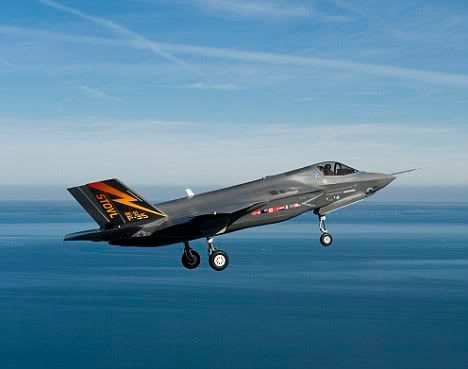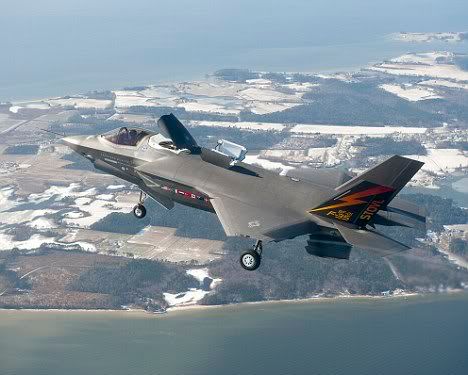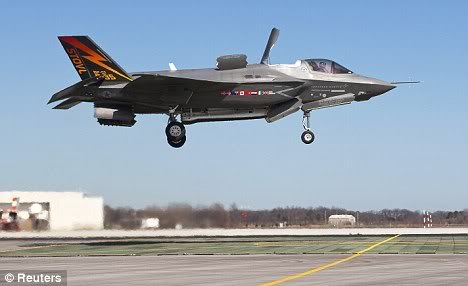She could prowl the depths of the oceans without stopping for her entire 25-year lifespan, her sleek curves undetected. She generates her own oxygen and fresh water from the surrounding sea, never has to refuel and never needs to break the surface. Indeed, the only reasons for her to come up after 90 days on patrol are to restock with food and to help preserve the sanity of her crew.
Astute is the world's most technologically advanced submarine, and remains a great British achievement despite overspends and delays. It is the stealthiest Royal Navy submarine ever to go to sea and its highly advanced Sonar 2076 system - capable of detecting the QE2 leaving New York all the way from the English Channel - is superior to the U.S. Navy equivalent. It can carry 38 weapons - heavyweight Spearfish torpedoes and Tomahawk Land Attack Missiles. The latter have a range of 1,000 nautical miles - enough to reach 96 per cent of the planet's populated areas from the sea.'If you've got a nuclear submarine operating, the great thing about it is that it scares people,' says Rear Admiral Mark Anderson, head of the Submarine Fighting Arm.
'They are scary things. We are a big military asset that can project into theatre at 500 miles a day without anybody knowing that we're doing it.'
It's over ten years since the last new British submarine entered service. But while HMS Vengeance and the other Vanguard-class subs have their job of patrolling with our Trident nuclear deterrent on board, the new Astute class will have to prove itself more flexible. It can hunt down submarines and ships, but it is also designed to lurk concealed off coasts for covert surveillance and intelligence-gathering. The traditional periscope has gone, to be replaced by a digital optical mast that can record 360 degrees with a zoom and produce infra-red and thermal imaging. The video can then be sent on to the rest of the fleet. Another mast is powerful enough to listen in on mobile-phone conversations far inshore.The Royal Navy and BAE Systems (which is building the vessel) are reticent on the subject, but Astute can also carry special forces to deploy from the submarine on secret operations using underwater sledges. Astute can move in quietly, act, then leave, and no one will know she's even been there.
Astute, the first in the class of the same name, is currently undergoing sea trials off the coast of Scotland. Having dived in shallow water, this week she will make her first deep dive, to a maximum depth of over 300 metres. Two further boats, Ambush and Artful, are under construction in the Cumbrian town of Barrow-in-Furness.
Only these three have actually been ordered by the Royal Navy, but nearly all the hull units are complete on a fourth, Audacious, while reactor components have been ordered for a fifth, Agamemnon. BAE workers hope they will build seven (there are plans for number six to be called Anson and the rumoured name for the seventh is Ajax). But doubts still remain about the Astute programme's future.
With the national debt high, an election looming and a strategic defence review pending, there is uncertainty in the air. At the end of the Cold War, delays in commissioning new submarines had a huge impact on the area and vital skills were lost.
This affected Astute's design and construction: a project signed off by John Major in 1997 at a cost of £2 billion will now see its first submarine enter service in the first half of 2011, and the price tag for the first three has climbed to £3.8 billion. Given the current debate over the future of the Trident nuclear missile system, some are questioning the need for further spending on submarines.
Money will be extremely tight, so some of our cherished projects will have to go to the wall,' says Lord Guthrie, former Chief of the Defence Staff.
'It depends on how ruthless an incoming government will be but we can't go on how we are - we're bust.'
It's now 50 years since the Queen launched Britain's first nuclear submarine, HMS Dreadnought, at Barrow-in-Furness. Altogether, 336 submarines have left Barrow's yards, but now there are fears that if boat builds are further delayed, skills could be lost again. Could the vessels currently under construction be the last great hurrah for British submarine building?
'Get ready, prepare for a push.'
Silence falls inside the 22m-long, 178-ton command deck module, the nerve centre of the submarine, as a piston eases the unit slowly into the hull of the submarine, like a giant Tube train carriage inching its way into a tunnel.
Behind us are the torpedo tubes, the control room and living quarters for the 98-man crew. In front through a doorway sits the Rolls-Royce pressurised water reactor.
'It's not much bigger than a dustbin,' says Andy Coles, commanding officer of Astute.
This is an extremely precise manoeuvre and a very tight fit, with only millimetres of space to play with on each side and on top. Within minutes we're standing still again - a piece of cabling is in danger of hitting a valve on the side of the module.
'It took 17 days to do this on the first boat and work in the whole dock hall stopped as everyone stood and watched,' says Gary Cunningham, who is managing the 'shipping' of the module.
'We were doing this for the very first time. On the second boat we knew what we were doing so it took just three days, and so far on this third boat it's going smoothly again.'
Traditionally the way to fit out a sub was with backbreaking work inside the hull - electronics would be assembled outside and tested, then stripped down, shipped in and built up again inside. Now they build huge modules, then drive them on a flat-bed transporter the few hundred yards along the road from the workshop to the final construction hall.
Isolated on the Cumbrian coast, Barrow-in-Furness has built warships and passenger liners (for P&O, Cunard and Orient Lines) since 1873 and was the base for Sir Barnes Neville Wallis when he designed airships for Vickers during World War I.
More recently, its yards have produced the ill-fated HMS Sheffield, lost in the Falklands, and the light aircraft carrier HMS Invincible. But it's for submarines that Barrow is best known. They have been built here since 1886 - petrol-powered, then diesel and now nuclear. The submarines used to be built outdoors, but now they are put together inside the cavernous Devonshire Dock Hall, opened by Margaret Thatcher in 1986. A giant steel-panelled structure, it looms over the town's 19th-century redbrick buildings.
From high inside the hall's cathedral-like space, Artful looks like a giant grounded whale attached to a life-support system of wires, pipes and cables, only its grey snub nose poking out the front of a latticework of scaffolding. Lilliputian figures in hard hats pop up occasionally along the length of it, climbing up old wooden ladders from inside its bowels.
Its partner, Ambush, on the other side of the hall, looks more like the finished product, with 40,000 black rubber tiles covering its graceful hull, its conning tower in place and torpedo tubes open giving it a sense of power and menace. Plywood and plastic coverings still perch along the length of its body to cover up what's deemed secret - particular attention is given to the way in and out for special forces, to the sonar equipment, and to the propulsor.
Each 97m-long boat appears vast outside but it's a different story beneath the skin. The interior is cramped though its conditions are a vast improvement on previous subs. Of course, the captain has his own private space, but for the first time each submariner has his own bunk (until now they have had to 'hot-bunk' between shifts). The junior ratings' mess has a plasma TV, and the well-equipped galley, where a rotating crew of five chefs offer 24-hour service, actually feels spacious.
Everywhere, however, still has a height clearance of only 1.95m so it still feels horribly enclosed for those unused to this environment.
Even before Astute comes into service, 300 designers and engineers have already begun work on the next-generation submarine: the proposed replacement for the Trident-carrying Vanguards. It's a £20 billion project, and one that's mired in controversy.
'Right now, land operations are the most likely thing to happen, therefore I think the lion's share of the defence budget should go to the Army,' says Lord Guthrie.
'At the moment the most important thing is Afghanistan, counterinsurgency, jihadis and terrorists - we need people for that, and they're more important than submarines.'
But Rear Admiral Mark Anderson prefers to think long-term.
'Yes, troops on the ground in Afghanistan are the current defence priority. But the long-term programme can't focus on just one conflict or crisis. You've got to be able to cover the other things that might happen around the world, and history tells us that those happen quite frequently. Submarines are a great place to hide without having anyone's permission to be based there or to deal with any access rights or overflight issues.
'Yes, submarines are very expensive, but with nuclear you're in it or you're out of it. We need to be building a submarine about every two years to keep the industry alive and to have an enduring national capability. My expectation is that all seven Astute boats will be built.'
But there will be tough decisions ahead for any incoming government on how best to spend the defence budget. It remains to be seen if the seventh boat will ever make it to sea or even be officially named - those working in the yards of Barrow hope she will not come to be known as Abandoned.
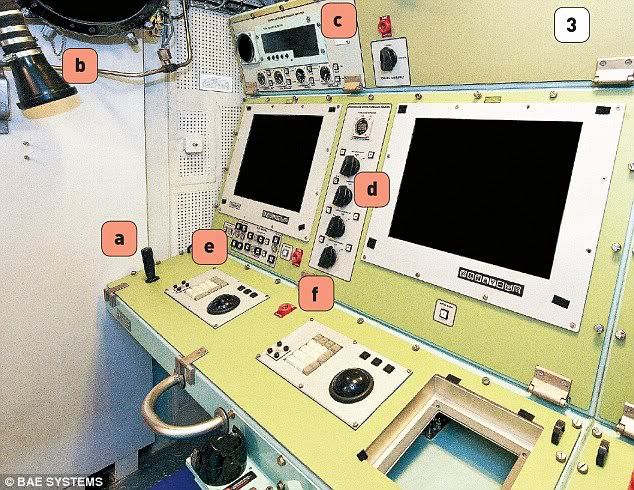
Planesman's position - the planesman operates the rudder and hydroplanes (which help to control the angle of dive) when the submarine is being operated manually: a) Manual steering control b) Voice pipe - acts as back-up for communicating with the reactor room if the phone fails c) L-shaped display shows sub's heading d) Steering and diving hydraulic control. Digital display at the top shows pressure; the knobs underneath control rudder and hydroplanes e) Large screen display shows details of sub's aspect (angle of dive); the buttons beneath control hydroplanes f) Red sockets are CO2 injection points - in case of an electrical fire an extinguisher can be plugged in to spray CO2 behind the panel

From far left: the grey command deck module is slowly pushed into Artful; sister vessel Ambush sits in a more complete state on the other side of the hall
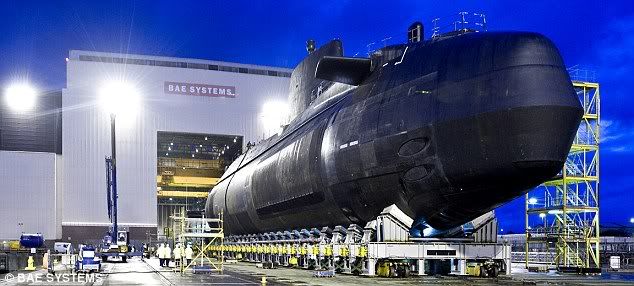
Astute sits on the shiplift outside the Devonshire Dock Hall in Barrow-in-Furness, ready to be lowered into the dock. The three starboard torpedo tubes are visible on the front of the submarine
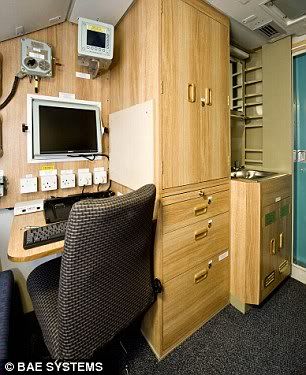
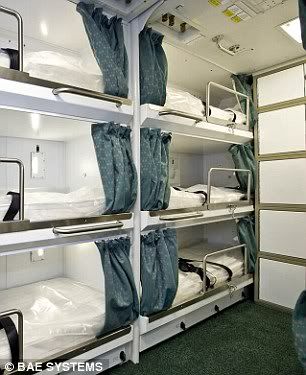
Bunks for the senior ratings (left) and the commanding officer's cabin (right)
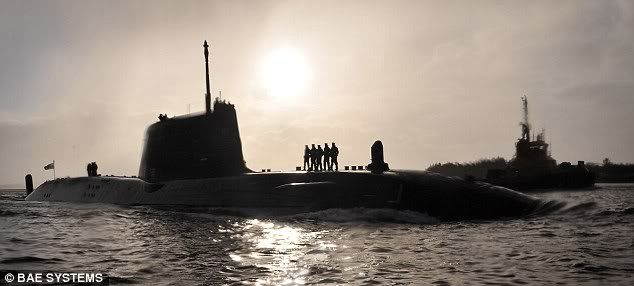
Astute arrives at her new home, Her Majesty's Naval Base Clyde, Faslane
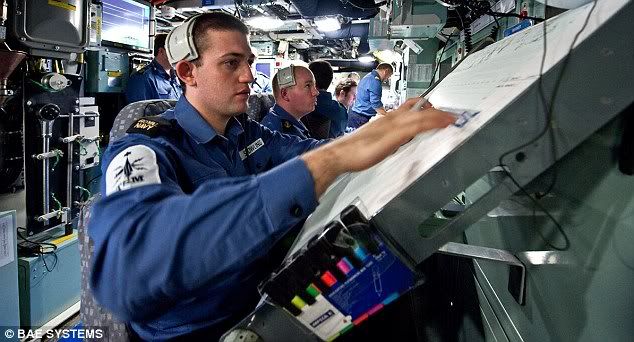
Crew members in the control room
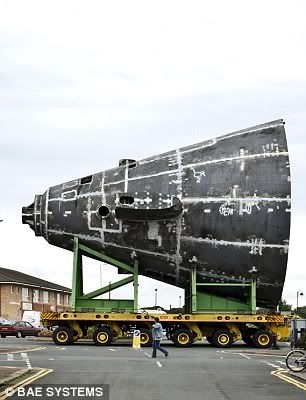
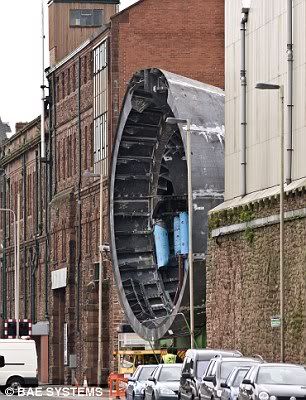
The aft end of Artful is transported along public roads from the workshop to the Devonshire Dock Hall
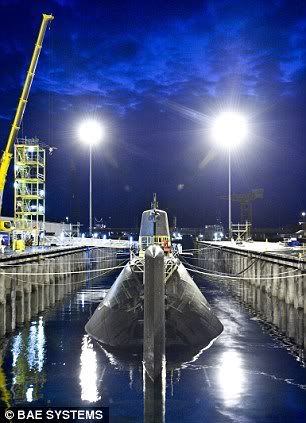
Astute in the water outside the dock hall












